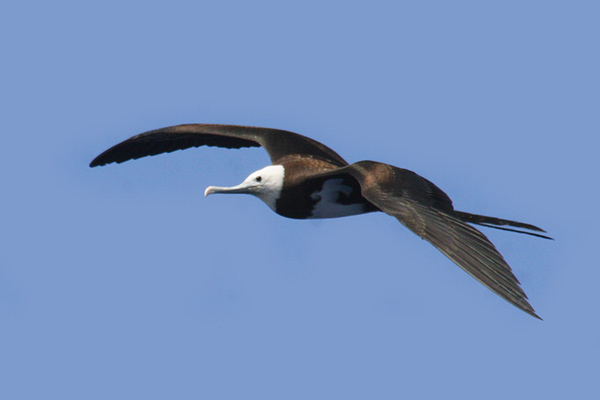
Fregata aquila
TAXONOMY
Fregata aquilia Linnaeus, 1758, Ascension Island.
OTHER COMMON NAMES
English: Ascension Island frigatebird; French: Frйgate aigle-demer;
German: Adlerfregattvogel; Spanish: Rabihorcado de Ascensiуn.
PHYSICAL CHARACTERISTICS
Body length of 35–38 in (89–96 cm), a wingspan of 77–79 in
(196–201 cm), and a weight of about 2.6 lb (1.2 kg). Males
have a greenish gloss on their black plumage, while females
are brownish on the upper breast, nape, and wing band. The
male has a bright red, inflatable throat sac used during
courtship.
DISTRIBUTION
Breeds on Ascension Island in the south Atlantic Ocean. It
mostly occurs near the breeding island but may also feed more
widely in waters of the south Atlantic.
HABITAT
Inhabits tropical and subtropical coastal waters, often near
mangrove forest.
BEHAVIOR
Outstanding fliers, they often soar to great heights. They are
silent at sea but noisy at the breeding colony.
FEEDING ECOLOGY AND DIET
Feed on flying fish caught in the air, on other small fish, squid,
and other marine food snatched at the sea’s surface and on
meals they force other seabirds to disgorge in flight. They also
feed on fishery offal and by-catch and predate the eggs and
young of other seabirds.
REPRODUCTIVE BIOLOGY
Lay a single egg in a low nest, usually built in a mangrove tree
or shrub. The egg is incubated by both parents. The chick is
naked when born and is fed by both parents. Sexual maturity is
at 5–7 years.
CONSERVATION STATUS
This species is considered Critically Endangered because it
breeds on only one tiny island, where its small and decreasing
population is severely threatened by predation by introduced
feral cats. It may also be at risk because of food depletion
caused by fishing activities in its feeding habitat.
SIGNIFICANCE TO HUMANS
Not of much importance to people, except for the economic
benefits of ecotourism related to birdwatching.
Other popular Animals
Photo Gallery of - Ascension frigatebird




 Animalia Life
Animalia Life